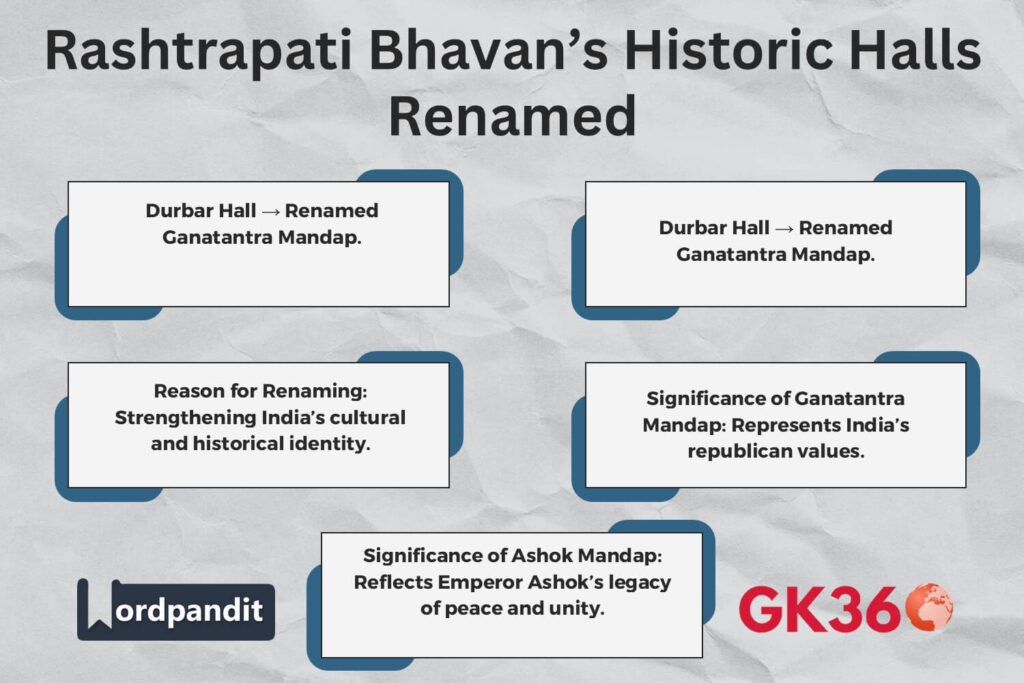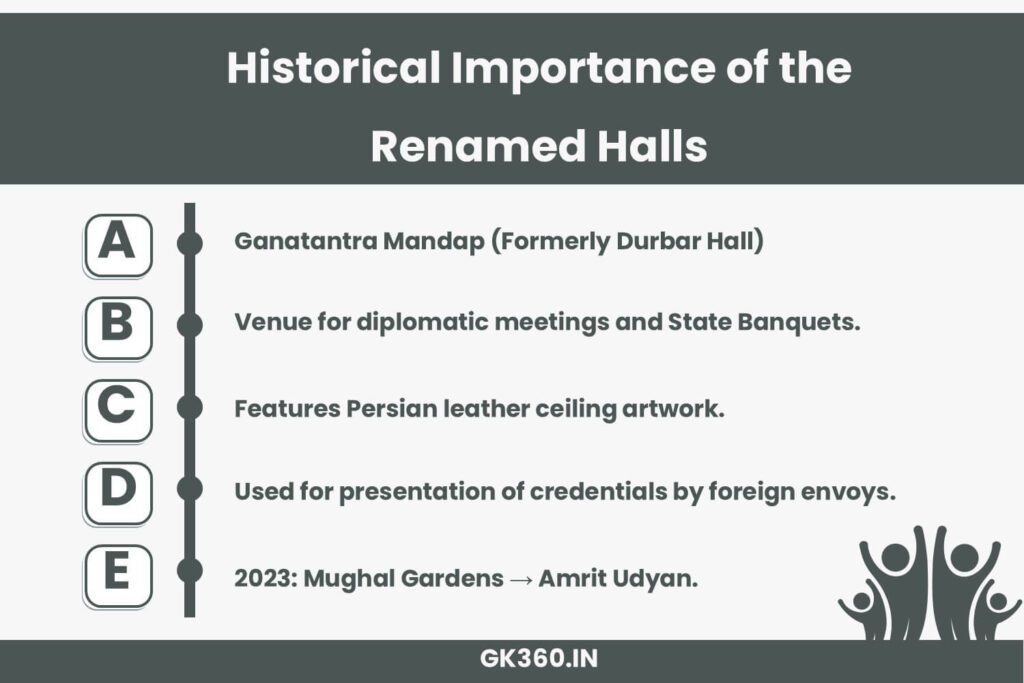Renaming of Rashtrapati Bhavan’s Grand Halls: A Reflection of Indian Heritage
Introduction
In a significant move to reflect Indian culture and ethos, Rashtrapati Bhavan’s grand Durbar Hall and Ashok Hall, traditionally used for ceremonies and celebrations, have been renamed Ganatantra Mandap and Ashok Mandap, respectively. This renaming aligns with ongoing efforts to imbue these historic locations with Indian identity and values.

Table of Contents
- Renaming of Halls
- Cultural Significance
- Historical Context
- Previous Renaming
- FAQs About the Renaming
- Conclusion
1. Renaming of Halls
- Durbar Hall is now Ganatantra Mandap.
- Ashok Hall is now Ashok Mandap.
2. Cultural Significance
- The renaming of these halls is a step towards emphasizing India’s cultural identity.
- Ganatantra Mandap aligns with India’s identity as a republic, underscoring the concept of ‘Ganatantra’ deeply rooted in Indian society.
- Ashok Mandap aims to eliminate traces of anglicization and uphold the values associated with the name ‘Ashok’, symbolizing freedom from suffering and representing Emperor Ashok’s legacy of unity and peaceful coexistence.
3. Historical Context
Ganatantra Mandap
- Located under the central dome of the erstwhile Vice Regal Lodge, Durbar Hall was initially known as the Throne Room.
- It hosted the swearing-in ceremony of C. Rajagopalachari as the Governor-General of India in 1948 and is used for civil and defense investiture ceremonies.
- Before 2014, government swearing-in ceremonies were held here but have since moved to the forecourt of the Rashtrapati Bhavan.
Ashok Mandap
- Heads of foreign missions present their credentials at Ashok Mandap.
- It serves as a formal introduction venue for visiting and Indian delegations before State Banquets.
- The ceiling features a leather painting of Fath Ali Shah, a Qajar ruler of Persia, hunting a tiger with his 22 sons.
4. Previous Renaming
- In 2023, the Mughal Gardens at Rashtrapati Bhavan were renamed Amrit Udyan, continuing the trend of renaming to reflect Indian heritage.
5. FAQs About the Renaming
- Why were the Durbar Hall and Ashok Hall renamed?
The renaming is part of an initiative to infuse Indian culture and identity into historical sites. - What does ‘Ganatantra Mandap’ signify?
It reflects India’s republican identity and emphasizes the democratic values enshrined in the Constitution. - What is the historical importance of Ashok Mandap?
It has been used for State Banquets, diplomatic meetings, and presenting credentials by foreign envoys. - How does this renaming align with previous heritage initiatives?
Similar renaming efforts, such as Mughal Gardens to Amrit Udyan, highlight India’s rich cultural heritage and values. - Where are these renamed halls located?
Both halls are inside Rashtrapati Bhavan, the official residence of the President of India.
6. Conclusion
The renaming of Rashtrapati Bhavan’s grand halls to Ganatantra Mandap and Ashok Mandap is a powerful reminder of India’s rich cultural heritage and identity. These changes signify a deeper connection to the nation’s roots and values, enhancing the symbolic significance of these historic spaces.
As students preparing for competitive exams, understanding such changes helps appreciate the ongoing efforts to reflect and celebrate India’s cultural ethos.
Call to Action:
Stay updated with more such insights into India’s rich heritage and current developments by visiting gk360.in. Enhance your general knowledge and be better prepared for your exams!
2. Key Takeaways Table
| Aspect | Details |
|---|---|
| Renamed Halls | Durbar Hall → Ganatantra Mandap & Ashok Hall → Ashok Mandap |
| Reason for Renaming | Strengthening India’s cultural identity |
| Ganatantra Mandap Significance | Represents India’s republican values |
| Ashok Mandap Significance | Honors Emperor Ashok’s legacy of peace and unity |
| Historic Functions | Swearing-in ceremonies, diplomatic meetings, investiture events |
| Previous Renaming | Mughal Gardens → Amrit Udyan (2023) |
| Located In | Rashtrapati Bhavan, the President of India’s official residence |
Related Terms:
- Rashtrapati Bhavan Hall Renaming 2024
- Ganatantra Mandap & Ashok Mandap Significance
- Durbar Hall Renamed Ganatantra Mandap
- Ashok Hall New Name Rashtrapati Bhavan
- Rashtrapati Bhavan Heritage Initiatives
- Ganatantra Mandap History & Importance
- India’s Cultural Identity in Public Spaces
- Renaming of Government Buildings in India
- Historical Halls of Rashtrapati Bhavan
- Ashok Mandap Diplomatic Importance






